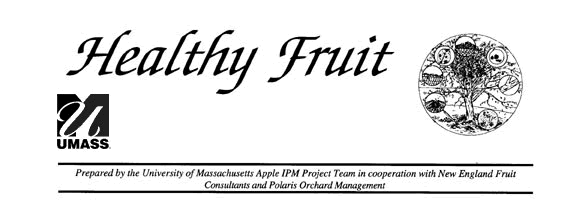|
|
|---|
|
Volume 6, No. 4 |
April 22, 1998 |
|
Savey/Apollo should be on by Early Pink. |
|
Progress Toward Bloom
McIntosh growth stages for various locations:
- Ashfield -- tight cluster
- Belchertown -- early pink
- Northboro -- early pink
- Sterling -- early pink
- Warren -- early pink
- Wilbraham -- early pink
To Treat Or Not To Treat
Emergence of adult leafminers started with a bang in most orchards which were at tight cluster early last week (4/13-4/14). Since then, there has been surprisingly little increase in activity, with the highest trap captures remaining around 30 LM/trap. From observations over the past several years, orchards which received an application of Provado in 1996 but not in 1997 are particularly vulnerable to the development of high leafminer populations early in the season. However, given the high LM populations of last year, most orchards did use a petal fall treatment.If trunk trap captures exceed thresholds for treatment (listed in the March Message as well as the April 8th issue of Healthy Fruit), we highly recommend a petal fall application of either Provado or Agrimek. For use against LM or European red mites, Agrimek must be accompanied by an adjuvant, and recent studies have shown that none is more effective than 1% refined horticultural spray oil. Both Provado and Agrimek have certain advantages, depending on the orchard situation. Provado will offer season-long control of both leafhoppers and aphids, but it is ineffective against mites. Agrimek holds the advantage that it offers very good control of mites through early July, but it is not effective against either leafhoppers or aphids.
Tarnished Plant Bug-out
Tarnished plant bug populations appear to be a non-issue thus far in monitored orchards. As mentioned in the 1998 March Message, this is the fourth straight year of low pressure, even though few orchards have used a prebloom spray targeting TPB. These low populations may be the result of several factors. For example, the TPB population may be reduced in response to the decrease in acreage of alfalfa fields, which are a prime site for TPB buildup. Or, TPB parasites released in New York and New England several years ago may be taking hold. Similar trends have been observed in other parts of New England and Quebec, which is welcome news indeed.
Show Time at the Apollo
European red mite egg hatch has been observed on wood samples collected last week. It is safe to assume that those areas in early pink are also experiencing the first stages of egg hatch. As it has been a fairly difficult spring to wedge in oil applications, we expect that many growers will utilize an early-season miticide. Recommendations for early-season mite treatments appear in the April 8th issue of Healthy Fruit.
Healthy Fruit is written by Dan Cooley, Ron Prokopy, Starker Wright, Wes Autio, and Karen Hauschild except where other contributors are noted. Edited by Dan Cooley. Publication is funded in part by the UMass Extension Agroecology Program, grower subscriptions, and the University of Massachusetts IPM Program. Please cite this source if reprinting information.
